
Starfish or sea stars are star-shaped echinoderms belonging to the class Asteroidea. Common usage frequently finds these names being also applied to ophiuroids, which are correctly referred to as brittle stars or basket stars. Starfish are also known as asteroids due to being in the class Asteroidea. About 1,900 species of starfish occur on the seabed in all the world's oceans, from warm, tropical zones to frigid, polar regions. They are found from the intertidal zone down to abyssal depths, at 6,000 m (20,000 ft) below the surface.

The Echinasteridae are a family of starfish in the monotypic order Spinulosida. The family includes eight genera and about 133 species found on the seabed in various habitats around the world.

The common sunstar or Solaster is a species of sea star belonging to the family Solasteridae. It is found in the northern parts of both the Atlantic and the Pacific Oceans.
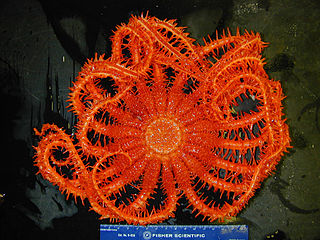
The Brisingids are deep-sea-dwelling starfish in the order Brisingida.

Henricia is a large genus of slender-armed sea stars belonging to the family Echinasteridae. It contains about fifty species.
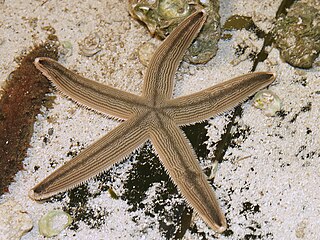
Luidia clathrata is a tropical species of starfish in the family Luidiidae. It is variously known as the slender-armed starfish, the gray sea star, or the lined sea star. It is found in the western Atlantic Ocean.

Asterias forbesi, commonly known as Forbes sea star, is a species of starfish in the family Asteriidae. It is found in shallow waters in the northwest Atlantic Ocean and the Caribbean Sea.

Luidia senegalensis, the nine-armed sea star, is a tropical species of starfish in the family Luidiidae found in the western Atlantic Ocean.
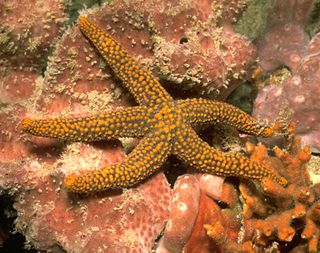
Echinaster spinulosus, the small spine sea star, is a species of sea star found in shallow parts of the western Atlantic Ocean, the Caribbean Sea and Gulf of Mexico.

Astropecten duplicatus, the two-spined sea star, is a starfish in the family Astropectinidae. It is found in the eastern Atlantic Ocean, the Caribbean Sea and the Gulf of Mexico.
Henricia lisa is a species of starfish in the family Echinasteridae found in deep water in the northern Atlantic Ocean.
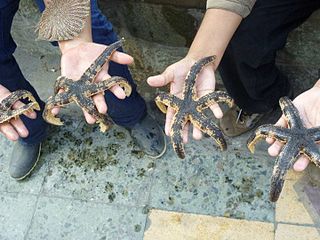
Luidia magellanica is a species of starfish in the family Luidiidae. It is found in the southeastern Pacific Ocean on the coast of South America.

Meyenaster is a genus of starfish in the family Asteriidae. It is a monotypic genus and the only species is Meyenaster gelatinosus which was first described by the Prussian botanist and zoologist Franz Julius Ferdinand Meyen in 1834. It is found in the southeastern Pacific Ocean on the coasts of South America.

Echinaster luzonicus, the Luzon sea star, is a species of starfish in the family Echinasteridae, found in shallow parts of the western Indo-Pacific region. It sometimes lives symbiotically with a copepod or a comb jelly, and is prone to shed its arms, which then regenerate into new individuals.

Henricia ornata, the reticulated starfish, is a species of starfish in the family Echinasteridae. It is native to the southeastern Atlantic Ocean on the coast of South Africa, the type locality being the Cape of Good Hope.
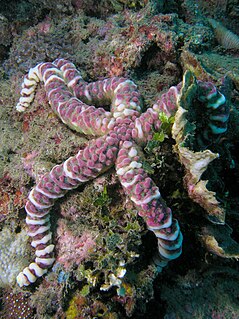
Echinaster callosus, the warty sea star or the banded bubble star, is a species of starfish found in shallow parts of the western Indo-Pacific region. The disc and five slender arms are covered with white, pink, red or violet warts, often forming transverse bands of colour on the arms.
Henricia oculata, commonly known as the bloody Henry starfish, is a species of starfish in the family Echinasteridae. It is native to northwestern Europe. It was first described as Asterias oculata by the British zoologist Thomas Pennant in 1777, later being transferred to the genus Henricia.

Freyella elegans is a species of deep-water starfish in the family Freyellidae in the order Brisingida, living at abyssal depths in the northwestern Atlantic Ocean.
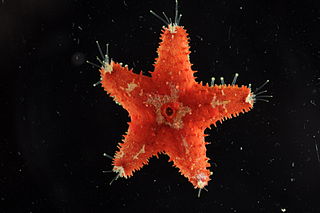
Euretaster insignis, commonly known as the striking sea star, is a species of starfish in the family Pterasteridae found in the central west Pacific Ocean. It is one of only three species in the order Velatida to be found in shallow water in the tropics. The young are brooded in a cavity underneath a "supradorsal" membrane.
Maureen Elizabeth Downey was an American zoologist who worked for three decades at the Smithsonian National Museum of Natural History. Known as "The Starfish Lady," she was an authority on sea stars and other echinoderms, co-founding the International Echinoderm Conference in 1972. Among her discoveries is Midgardia xandaros, the world's largest starfish.
















